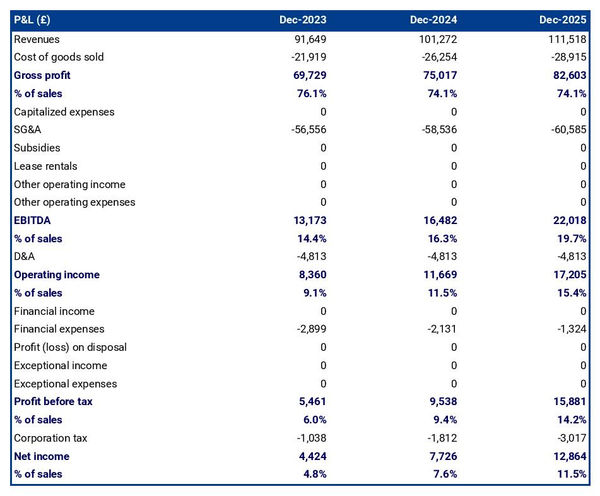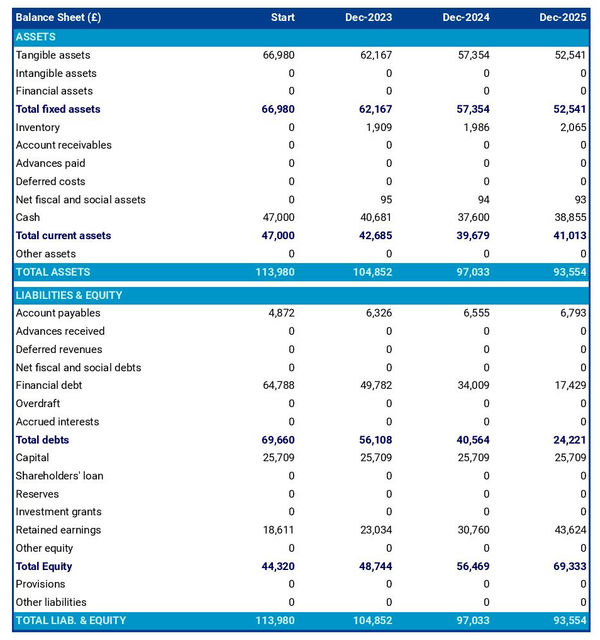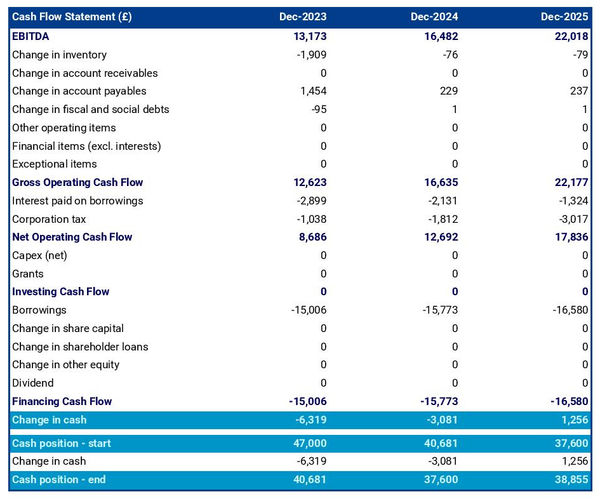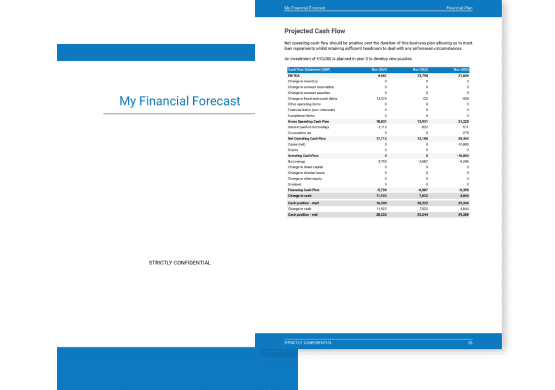How to create a financial forecast for a gourmet restaurant?

Developing and maintaining an up-to-date financial forecast for your gourmet restaurant is key in order to maintain visibility on your business’s future cash flows.
If you feel overwhelmed at the thought of putting together a gourmet restaurant financial forecast then don’t worry as this guide is here to help you.
We'll cover everything from: the main objectives of a financial forecast, the data you need to gather before starting, to the tables that compose it, and the tools that will help you create and maintain your forecast efficiently.
Let's get started!
Why create and maintain a financial forecast for a gourmet restaurant?
In order to prosper, your business needs to have visibility on what lies ahead and the right financial resources to grow. This is where having a financial forecast for your gourmet restaurant becomes handy.
Creating a gourmet restaurant financial forecast forces you to take stock of where your business stands and where you want it to go.
Once you have clarity on the destination, you will need to draw up a plan to get there and assess what it means in terms of future profitability and cash flows for your gourmet restaurant.
Having this clear plan in place will give you the confidence needed to move forward with your business’s development.
Having an up-to-date financial forecast for a gourmet restaurant is also useful if your trading environment worsens, as the forecast enables you to adjust to your new market conditions and anticipate any potential cash shortfall.
Finally, your gourmet restaurant's financial projections will also help you secure financing, as banks and investors alike will want to see accurate projections before agreeing to finance your business.
Need a solid financial forecast?
The Business Plan Shop does the maths for you. Simply enter your revenues, costs and investments. Click save and our online tool builds a three-way forecast for you instantly.

What information is needed to build a gourmet restaurant financial forecast?
The quality of your inputs is key when it comes to financial modelling: no matter how good the model is, if your inputs are off, so will the forecast.
If you are building a financial plan to start a gourmet restaurant, you will need to have done your market research and have a clear picture of your sales and marketing strategies so that you can project revenues with confidence.
You will also need to have a clear idea of what resources will be required to operate the gourmet restaurant on a daily basis, and to have done your research with regard to the equipment needed to launch your venture (see further down this guide).
If you are creating a financial forecast of an existing gourmet restaurant, things are usually simpler as you will be able to use your historical accounting data as a budgeting base, and complement that with your team’s view on what lies ahead for the years to come.
Let's now zoom in on what will go in your gourmet restaurant's financial forecast.
The sales forecast for a gourmet restaurant
The sales forecast, also called topline projection, is normally where you will start when building your gourmet restaurant financial forecast.
Creating a coherent sales projection boils down to estimating two key drivers:
- The average price
- The number of monthly transactions
To do this, you will need to rely on historical data (for an existing business), market research data (for both new and existing gourmet restaurants), and consider the elements below:
- Seasonal Fluctuations: As a gourmet restaurant, your menu may change with the seasons, which can affect the average price of your dishes. For example, during the summer months, you may offer lighter and more refreshing dishes that are less expensive to produce, resulting in a lower average price. On the other hand, during the winter months, you may offer heartier and more indulgent dishes that are more expensive to produce, resulting in a higher average price.
- Economic Conditions: Economic factors, such as inflation and unemployment rates, can also impact the average price of your dishes. During times of economic downturn, consumers may be more price-sensitive and opt for more affordable dining options. This may require you to adjust your menu and prices accordingly to maintain your average price.
- Special Events and Holidays: Special events and holidays, such as Valentine's Day or Christmas, can also affect the average price of your dishes. During these occasions, consumers may be willing to spend more on a special meal, allowing you to increase your prices and potentially increase your average price for the month.
- Competition: Your average price may also be impacted by your competition in the area. If there are other gourmet restaurants nearby, you may need to adjust your prices to remain competitive. Alternatively, if you are the only gourmet restaurant in the area, you may be able to charge a higher average price due to limited competition.
- Customer Preferences: The preferences of your customers can also influence your average price. If your target market is willing to pay more for high-quality and unique dishes, you may be able to charge a higher average price. On the other hand, if your customers are more price-sensitive, you may need to adjust your prices accordingly to maintain your average price.
After the sales forecast comes the operating expenses budget, which we will now look into in more detail.
Need inspiration for your business plan?
The Business Plan Shop has dozens of business plan templates that you can use to get a clear idea of what a complete business plan looks like.

The operating expenses for a gourmet restaurant
The next step is to estimate the costs you’ll have to incur to operate your gourmet restaurant.
These will vary based on where your business is located, and its overall size (level of sales, personnel, etc.).
But your gourmet restaurant's operating expenses should normally include the following items:
- Staff costs: This includes wages, salaries, benefits, and any other expenses related to your employees. As a gourmet restaurant, you may have higher staff costs due to the specialized skills and training required.
- Food and beverage costs: These are the costs associated with purchasing ingredients and beverages for your menu items. As a gourmet restaurant, you may have higher food costs due to the use of high-quality and unique ingredients.
- Rent or lease: This is the cost of renting or leasing your restaurant space. As a gourmet restaurant, you may be located in a prime location with higher rent or lease rates.
- Utilities: This includes electricity, gas, water, and other utility expenses. As a gourmet restaurant, you may have higher utility costs due to the use of specialized equipment and appliances.
- Marketing and advertising: These are the costs associated with promoting your restaurant and attracting customers. As a gourmet restaurant, you may invest in higher-end marketing tactics to target a specific audience.
- Inventory: This is the cost of purchasing and maintaining inventory for your restaurant, including food, beverages, and other supplies. As a gourmet restaurant, you may have a larger and more diverse inventory.
- Insurance costs: This includes both general liability insurance and worker's compensation insurance. As a gourmet restaurant, you may have higher insurance costs due to the potential risks associated with food preparation and serving.
- Accountancy fees: These are the costs of hiring an accountant or accounting firm to manage your financial records and taxes. As a gourmet restaurant, you may have more complex financials and require more specialized accounting services.
- Software licenses: This includes any software or technology licenses needed to operate your restaurant, such as point-of-sale systems, reservation systems, or inventory management software. As a gourmet restaurant, you may invest in more advanced software to enhance the customer experience.
- Banking fees: These are the fees associated with maintaining a business bank account and processing transactions. As a gourmet restaurant, you may have higher banking fees due to a larger volume of transactions and the use of specialized payment methods.
- Cleaning and maintenance: This includes the cost of cleaning services and maintenance for your restaurant, including equipment and building upkeep. As a gourmet restaurant, you may have higher cleaning and maintenance costs due to the use of specialized equipment and the need for a pristine dining environment.
- Waste disposal: This is the cost of disposing of waste and recycling for your restaurant. As a gourmet restaurant, you may produce more waste due to the use of high-quality ingredients and the need for proper food storage and preparation.
- Training and development: These are the costs associated with training and developing your staff to maintain high-quality standards and keep up with industry trends. As a gourmet restaurant, you may invest in specialized training programs for your employees.
- Legal fees: This includes the cost of hiring a lawyer for any legal services related to your restaurant, such as contracts, permits, or disputes. As a gourmet restaurant, you may have higher legal fees due to the complexity of the food industry.
- Taxes and licenses: These are the costs associated with taxes and business licenses required to operate your restaurant. As a gourmet restaurant, you may have higher taxes and licensing fees due to a larger revenue and potential for specialized permits.
This list is not exhaustive by any means, and will need to be tailored to your gourmet restaurant's specific circumstances.
What investments are needed to start or grow a gourmet restaurant?
Creating and expanding a gourmet restaurant also requires investments which you need to factor into your financial forecast.
Capital expenditures and initial working capital items for a gourmet restaurant could include elements such as:
- Kitchen equipment: This includes items such as commercial ovens, refrigerators, and other specialized equipment needed for preparing gourmet dishes.
- Interior design and decor: Creating a luxurious and inviting atmosphere is crucial for a gourmet restaurant. This may involve purchasing high-end furniture, lighting fixtures, and artwork.
- Wine cellar: Many gourmet restaurants offer an extensive wine selection, and a well-stocked and climate-controlled wine cellar is essential for storing and aging these wines.
- Tableware and serving utensils: Gourmet restaurants often invest in high-quality tableware, cutlery, and serving utensils to enhance the dining experience for their customers.
- Technology and POS systems: A modern and efficient point-of-sale system, along with other technology such as reservation systems and kitchen display systems, is necessary for a gourmet restaurant to run smoothly.
Again, this list is not exhaustive and will need to be adjusted according to the circumstances of your gourmet restaurant.
Need a convincing business plan?
The Business Plan Shop makes it easy to create a financial forecast to assess the potential profitability of your projects, and write a business plan that’ll wow investors.

The financing plan of your gourmet restaurant
The next step in the creation of your financial forecast for your gourmet restaurant is to think about how you might finance your business.
You will have to assess how much capital will come from shareholders (equity) and how much can be secured through banks.
Bank loans will have to be modelled so that you can separate the interest expenses from the repayments of principal, and include all this data in your forecast.
Issuing share capital and obtaining a bank loan are two of the most common ways that entrepreneurs finance their businesses.
What tables compose the financial plan for a gourmet restaurant?
Now let's have a look at the main output tables of your gourmet restaurant's financial forecast.
The forecasted profit & loss statement
The profit & loss forecast gives you a clear picture of your business’ expected growth over the first three to five years, and whether it’s likely to be profitable or not.

A healthy gourmet restaurant's P&L statement should show:
- Sales growing at (minimum) or above (better) inflation
- Stable (minimum) or expanding (better) profit margins
- A healthy level of net profitability
This will of course depend on the stage of your business: numbers for an established gourmet restaurant will look different than for a startup.
The projected balance sheet
Your gourmet restaurant's projected balance sheet provides a snapshot of your business’s financial position at year-end.
It is composed of three types of elements: assets, liabilities and equity:
- Assets: represent what the business possesses including cash, equipment, and accounts receivable (money owed by clients).
- Liabilities: represent funds advanced to the business by lenders and other creditors. They include accounts payable (money owed to suppliers), taxes payable and loans from banks and financial institutions.
- Equity: is the combination of what has been invested by the business owners and the cumulative profits and losses generated by the business to date (which are called retained earnings). Equity is a proxy for the value of the owner's stake in the business.

The projected cash flow statement
A projected cash flow statement for a gourmet restaurant is used to show how much cash the business is generating or consuming.

The cash flow forecast is usually organised by nature to show three key metrics:
- The operating cash flow: do the core business activities generate or consume cash?
- The investing cash flow: how much is the business investing in long-term assets (this is usually compared to the level of fixed assets on the balance sheet to assess whether the business is regularly maintaining and renewing its equipment)?
- The financing cash flow: is the business raising new financing or repaying financiers (debt repayment, dividends)?
Cash is king and keeping an eye on future cash flows is imperative for running a successful business. Therefore, you should pay close attention to your gourmet restaurant's cash flow forecast.
If you are trying to secure financing, note that it is customary to provide both yearly and monthly cash flow forecasts in a financial plan - so that the reader can analyze seasonal variation and ensure the gourmet restaurant is appropriately capitalised.
Need a solid financial forecast?
The Business Plan Shop does the maths for you. Simply enter your revenues, costs and investments. Click save and our online tool builds a three-way forecast for you instantly.

Which tool should you use to create your gourmet restaurant's financial forecast?
Creating your gourmet restaurant's financial forecast may sound fairly daunting, but the good news is that there are several ways to go about it.
Using online financial forecasting software to build your gourmet restaurant's projections
The modern and easiest way is to use an online financial forecasting tool such as the one we offer at The Business Plan Shop.
There are several advantages to using specialised software:
- You can easily create your financial forecast by letting the software take care of the financial calculations for you without errors
- You have access to complete financial forecast templates
- You get a complete financial forecast ready to be sent to your bank or investors
- You can easily track your actual financial performance against your financial forecast, and recalibrate your forecast as the year goes by
- You can create scenarios to stress test your forecast's main assumptions
- You can easily update your forecast as time goes by to maintain visibility on future cash flows
- You have a friendly support team on standby to assist you when you are stuck
- It’s cost-efficient and much cheaper than using an accountant or consultant (see below)
If you are interested in this type of solution, you can try our projection software for free by signing up here.
Calling in a financial consultant or chartered accountant
Enlisting the help of a consultant or accountant is also a good way to obtain a professional gourmet restaurant financial forecast.
The downside of this solution is its cost. From experience, obtaining a simple financial forecast over three years (including a balance sheet, income statement, and cash flow statement) is likely to cost a minimum of £700 or $1,000.
The indicative cost above, is for a small business, and a forecast is done as a one-shot exercise. Using a consultant or accountant to track your actuals vs. forecast and to keep your financial projections up to date on a monthly or quarterly basis will cost a lot more.
If you opt for this solution, make sure your accountant has in-depth knowledge of your industry, so that they may challenge your figures and offer insights (as opposed to just taking your assumptions at face value to create the forecast).
Why not use a spreadsheet such as Excel or Google Sheets to build your gourmet restaurant's financial forecast?
Creating an accurate and error-free gourmet restaurant financial forecast on Excel (or any spreadsheet) is very technical and requires both a strong grasp of accounting principles and solid skills in financial modelling.
Most entrepreneurs lack the expertise required to create an accurate financial forecast using spreadsheet software like Excel or Google Sheets. As a result, it is unlikely anyone will trust your numbers.
The second reason is that it is inefficient. Building forecasts on spreadsheets was the only option in the 1990s and early 2000s, nowadays technology has advanced and software can do it much faster and much more accurately.
This is why professional forecasters all use software. With the rise of AI, software is also becoming smarter at helping us detect mistakes in our forecasts and helping us analyse the numbers to make better decisions.
Finally, like everything with spreadsheets, tracking actuals vs. forecasts and updating your forecast as the year progresses is manual, tedious, error-prone, and time-consuming. Whereas financial forecasting software like The Business Plan Shop is built for this.
Need a convincing business plan?
The Business Plan Shop makes it easy to create a financial forecast to assess the potential profitability of your projects, and write a business plan that’ll wow investors.

Use our financial projection templates for inspiration
The Business Plan Shop has dozens of financial forecasting templates available.
Our examples contain both the financial forecast, and a written business plan which presents, in detail, the company, the team, the strategy, and the medium-term objectives.
Whether you are just starting out or already have your own gourmet restaurant, looking at our template is always a good way to get ideas on how to model financial items and what to write when creating a business plan to secure funding.

Takeaways
- A financial forecast shows expected growth, profitability, and cash generation metrics for your gourmet restaurant.
- Tracking actuals vs. forecast and having an up-to-date financial forecast is key to maintaining visibility on your future cash flows.
- Using financial forecasting software is the modern way of creating and maintaining financial projections.
We hope that this guide helped you gain a clearer perspective on the steps needed to create the financial forecast for a gourmet restaurant. Don't hesitate to contact us if you have any questions!
Need inspiration for your business plan?
The Business Plan Shop has dozens of business plan templates that you can use to get a clear idea of what a complete business plan looks like.

Also on The Business Plan Shop
Know someone who runs a gourmet restaurant? Share our business guide with them!




